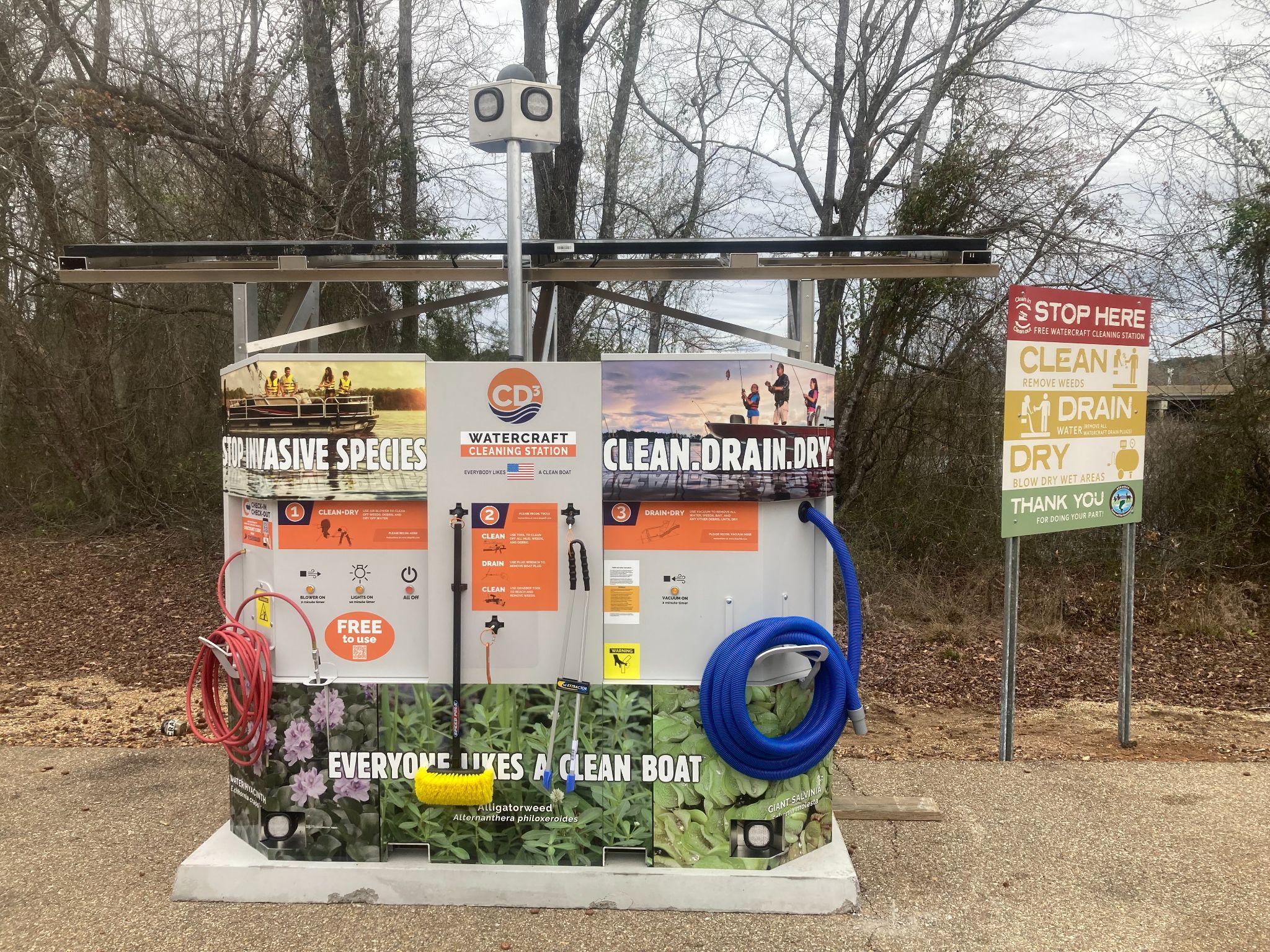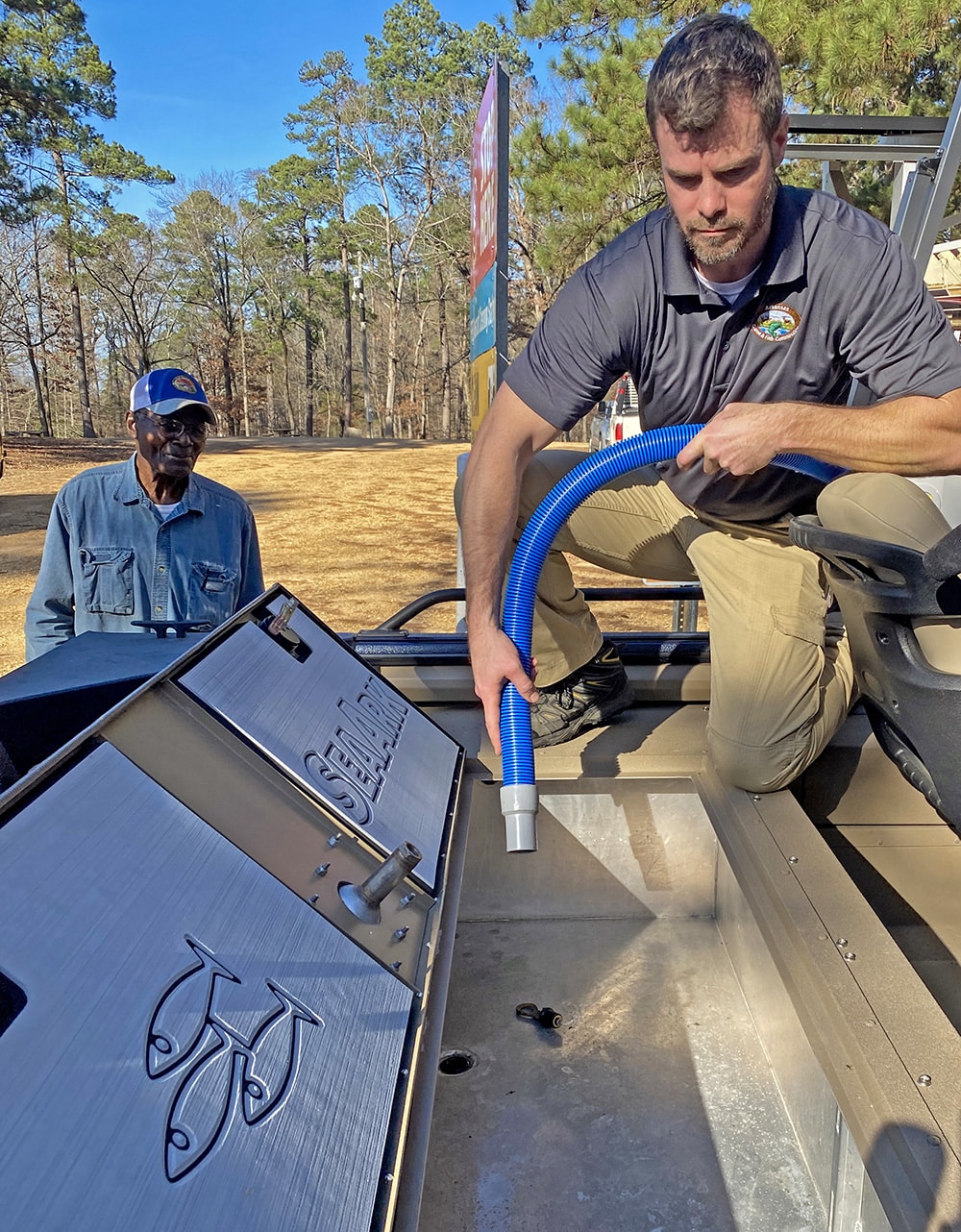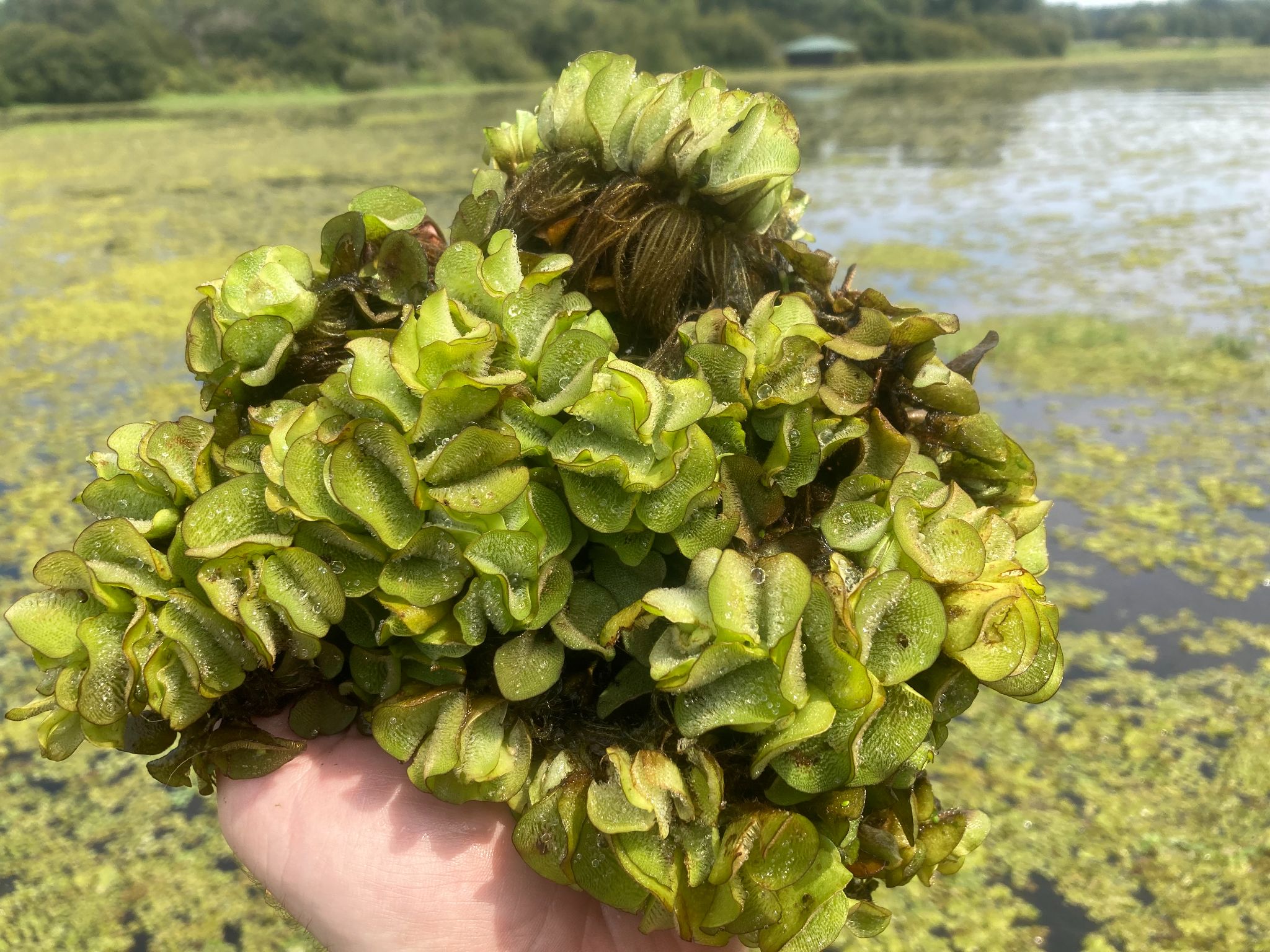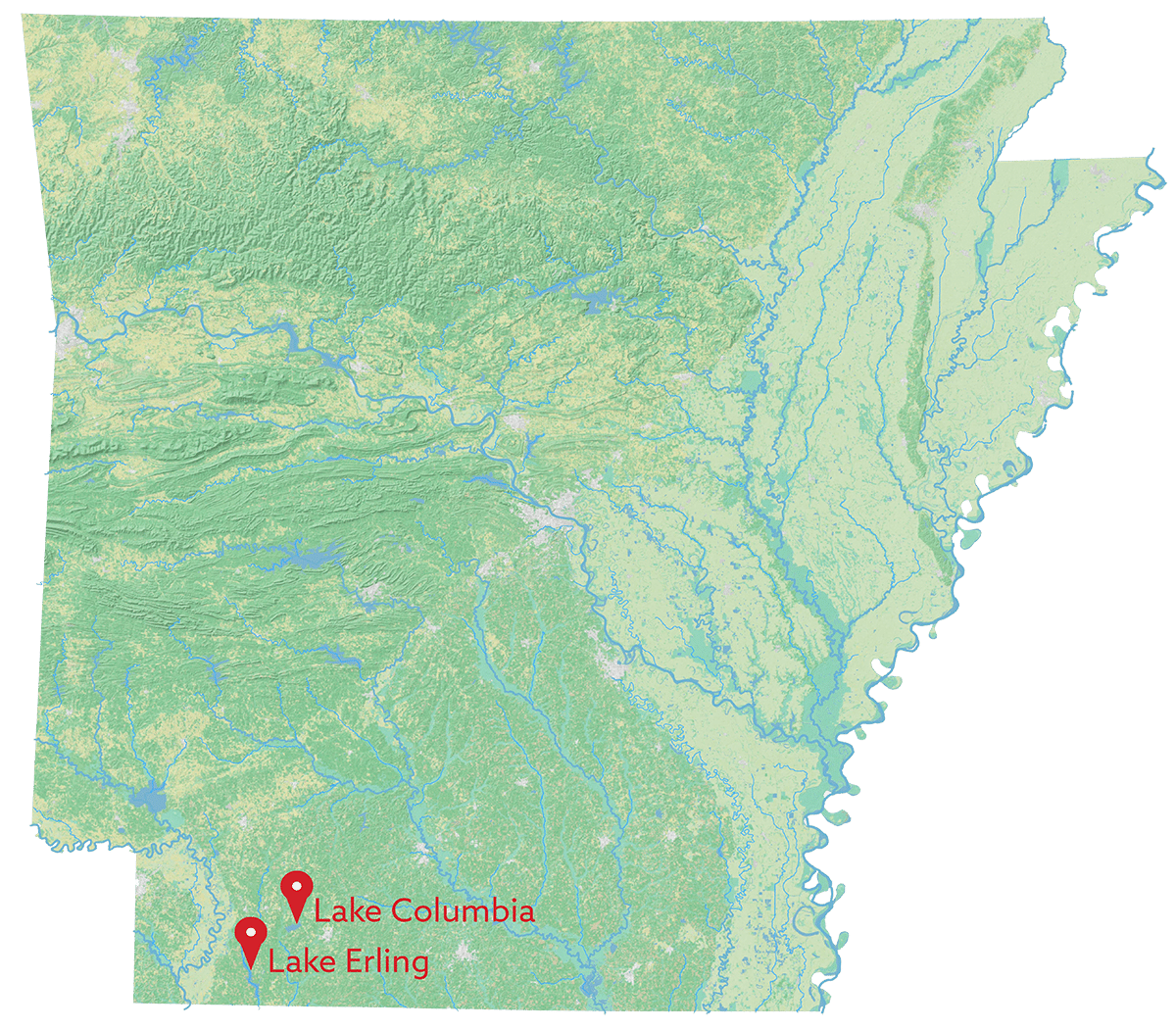AGFC adds second boat-cleaning station in south Arkansas
ON 03-06-2024

MAGNOLIA — Boaters and anglers have a new tool to help clean their boats of debris at Lake Columbia, and the Arkansas Game and Fish Commission hopes it tips the scales in the fight against aquatic nuisance species. Last week, AGFC staff installed a waterless, solar-powered watercraft cleaning station at Beech Creek Access in Columbia County for boaters to use as they leave the lake to prevent the spread of giant salvinia or other invasive aquatic plants that may be trying to hitch a ride on their boats and trailers.
This is the second such cleaning station the AGFC has deployed in south Arkansas.
“Installing the self-service watercraft cleaning station at this access will allow anglers to help contain giant salvinia in the lake by providing free tools to remove water, weeds, and debris from their boats before leaving the access area,” Matt Horton, Aquatic Nuisance Species Program coordinator for the AGFC, said. “A similar cleaning station installed by the AGFC at AGRED Park on Lake Erling has been used more than 300 times since it was installed just over a year ago. These cleaning stations have proven themselves effective tools in preventing the spread of aquatic invasive species in Arkansas as well as other states.”
The cleaning station is equipped with an air blower, wet-dry vacuum and hand tools to remove vegetation and water from boats and trailers, all powered by an onboard battery system that’s recharged through solar panels.

“The onboard software system allows us to track daily tool usage and monitor equipment function remotely,” Horton said. “Lights on the station also make it easier for anglers to use at night if the fishing action keeps them after sundown.”
Lake Columbia is a 3,000-acre reservoir owned by Columbia County and is the municipal water supply for the city of Magnolia and surrounding area. The AGFC manages the lake’s fishery, and it is a very popular destination in southwest Arkansas for recreational boating, fishing and waterfowl hunting. Since giant salvinia was discovered at Lake Columbia in 2019, AGFC has worked closely with the Columbia County Rural Development Authority to install floating containment booms at the northshore and southshore boat ramps to prevent the invasive plant from floating into the boat ramp area and hitching a ride on boats and trailers.
Horton said Beech Creek Access’ size and location near the main creek channel made the installation of such a boom system infeasible.
A video of the new boat-cleaning station in action is available at https://www.youtube.com/watch?
Giant salvinia is an invasive floating aquatic fern native to South America. It only takes a tiny fragment of the plant to reproduce and is capable of doubling in mass every four days. Lakes where it has been found are at risk of the plant covering the water surface and choking out sunlight and oxygen necessary for fish and other aquatic life to survive. It displaces native plants used by fish, waterfowl and other wildlife for food and habitat, and can create dense mats up to 3 feet thick that block fishing, boating and other recreation.

“It also has the potential to impact water quality and the lake’s use as a municipal water supply for the city of Magnolia and surrounding area,” Horton said.

Giant salvinia has been detected in five lakes in Arkansas since it was first discovered in Arkansas in 2017, including Smith Park Lake in Miller County, Lake Erling, Lake Columbia, Millwood Lake and Mercer Bayou. Through early detection and intensive eradication efforts, it was successfully eradicated from all waters except lakes Columbia and Erling, where it has become established and spread throughout these lakes. All introductions appeared to result from giant salvinia hitchhiking on boats, trailers, and hunting and fishing equipment. It is prevalent in almost all major waters in Louisiana and several waters in south Texas and Mississippi. The plant can survive out of the water on boat trailers and moist environments for a week or more.
“It is critical that all boaters, including anglers, recreational boaters and hunters using boats, to thoroughly inspect their boats, motors, trailers, livewells, fishing nets and recreational equipment, and remove any debris and vegetation prior to leaving the boat ramp,” Horton said. “It can easily snag on boat trailer axles, bunks, sonar transducers, trolling motors and any part of the boat and trailer that contacts the water.”
Horton has some easy to remember recommendations everyone should follow to reduce the risk of transporting giant salvinia from infested waters: Just clean, drain and dry your boat, motor and trailer.
-
Clean — Inspect the boat, livewell, trailer and motor and remove all debris, mud and vegetation. Clean all livewells, bilge pumps, ballast tanks and other areas that hold or pump water in addition to exterior surfaces. Once completed, if possible, boat owners should wash their boats and trailers with high-pressure, hot water.
-
Drain — Remove all drain plugs at the boat ramp and allow all water to drain from the vessel. This requirement became law in 2020.
-
Dry — Allow the boat and trailer to dry, preferably for five days, before transporting the boat to a new body of water. These few steps will help ensure other water bodies don’t become infested with giant salvinia or other aquatic nuisance species.
Boaters should report giant salvinia or other aquatic nuisance species to the AGFC immediately by going to www.agfc.com/ans and submitting an online report or contacting Horton at 501-747-9012. Please remember to include clear pictures for identification and note the exact location (GPS coordinate preferred) where the observation occurred.
####
CUTLINES:
CLEANING STATION
A new boat cleaning station at Lake Columbia will help anglers and other boaters fight the spread of aquatic nuisance species in Arkansas.
VACUUMING LIVEWELL
Horton demonstrates the battery-operated vacuum to an angler at the boat cleaning station at Lake Erling.
HANDFUL OF PLANTS
Giant salvinia is an invasive floating fern from South America. It can choke out native vegetation and smother fish and aquatic habitat.
MAP
Lakes Erling and Columbia are the only two lakes where giant salvinia persists in Arkansas as of January 2024. It has been found and eradicated in three other locations thanks to the help and watchful eye of anglers and boaters.
Recent News

Arkansas Wildlife Weekly Fishing Report
Jul. 10, 2025

Lonoke aquaculturist named to AGFC
Jul. 10, 2025
Subscribe to Our Weekly Newsletter E-mails
Don’t miss another issue. Sign up now to receive the AGFC Wildlife Weekly Newsletter in your mailbox every Wednesday afternoon (Waterfowl Reports are published weekly during waterfowl season and periodically outside the season). Fishing Reports arrive on Thursdays. Fill in the following fields and hit submit. Thanks, and welcome!
